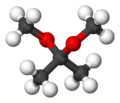2,2-Dimethoxypropane
| |||
| Names | |||
|---|---|---|---|
| IUPAC name
2,2-dimethoxypropane | |||
| Other names
acetone dimethyl acetal | |||
| Identifiers | |||
| 77-76-9 | |||
| 3D model (Jmol) | Interactive image | ||
| ChemSpider | 21106033 | ||
| ECHA InfoCard | 100.000.961 | ||
| |||
| Properties | |||
| C5H12O2 | |||
| Molar mass | 104.15 g/mol | ||
| Appearance | Colorless liquid | ||
| Density | 0.85 g/cm3 | ||
| Melting point | −47 °C (−53 °F; 226 K) | ||
| Boiling point | 83 °C (181 °F; 356 K) | ||
| 15 g/L (20 °C) | |||
| Hazards | |||
| Safety data sheet | External MSDS | ||
| Except where otherwise noted, data are given for materials in their standard state (at 25 °C [77 °F], 100 kPa). | |||
| | |||
| Infobox references | |||
2,2-Dimethoxypropane or acetone dimethyl acetal or DMP is an organic compound and an alkylating reagent. The chemical formula is C5H12O2 and the molecular formula is (CH3)2C(OCH3)2. It is the acetalisation product of acetone and methanol. Dimethoxypropane is an intermediate for the synthesis of 2-methoxypropene. In histology, DMP is now considered to be more efficient than ethanol for the dehydration of animal tissue.
DMP is commonly used as a water scavenger in water-sensitive reactions -- any available water will react with DMP to form acetone and methanol.
References
External links
This article is issued from Wikipedia - version of the 3/16/2016. The text is available under the Creative Commons Attribution/Share Alike but additional terms may apply for the media files.

